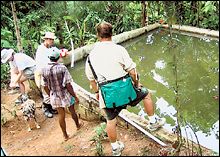 |
 |
| Want to send this page or a link to a friend? Click on mail at the top of this window. |
| Posted December 3, 2003 |
| In Haiti: feed the fish, then the people |
 |
| GROWING FOOD: U.S. scientists are working with Haitians to create a nutritious pellet to feed tilapia. Haitian ponds produce only 10 to 20 pounds of the fish, but could eventually provide 600 pounds. BILL COBB |
| By Lori Valigra, Contributor to The Christian Science Monitor |
Sweet and flaky tilapia often graces the dinner tables of Americans, surpassing trout as one of the most popular fish to eat. But in its native tropical habitat in countries like impoverished Haiti, the tilapia often remains a runt - as malnourished as the local people.
Some American researchers hope to change that. Working with local missionaries in the L'Acul area of Haiti's northwest coast, some 40 miles from Port-au-Prince, the scientists are trying to increase the fish's weight substantially, from 10 grams to about 450 grams. Their secret weapon: a nutritious fish-food pellet made from local Haitian tree l
Their aim is to produce about a one-pound fish, almost half of which would be edible animal protein, a key ingredient missing from the average Haitian's 800-calorie daily diet. Haiti - one of the poorest countries in the world, where 80 percent of the population lives in poverty and 70 percent are unemployed - represents a key experiment in using seafood to alleviate human hunger in the world.
The Marine Biological Laboratory (MBL) in Woods Hole, Mass., which is directing pellet production for the Haiti initiative, hopes to expand the program to other islands and impoverished nations.
Currently, some 800 million people remain undernourished worldwide. Seafood-improvement programs could boost and diversify their food stocks, scientists say.
While tilapia grow quickly in hatcheries when fed properly, in Haiti their only food source is algae and surrounding vegetation or bugs that might fall into the water.
Commercial fish food sent to Haiti spoils rapidly because of heat, lack of refrigeration, and difficulty in transporting it to rural mountain areas. Another problem: When commercial food arrives from other countries, some Haitians eat it instead of giving it to the fish.
"Typical commercial fish foods made here in the States are probably more nutritious than anything down there that they would be able to eat," says Bill Mebane, superintendent of the aquaculture engineering division of MBL's Marine Resources Center. "A lot of our fish food has a very high percentage of animal protein in it, as it's primarily made from fish meal."
The marine lab got involved in the program through Mr. Mebane's parents at a church in Pennsylvania that helps missionaries in Haiti.
The missionaries, Rodney and Sharyn Babe, have worked for the past 10 years to reforest the L'Acul area with nitrogen-fixing trees that also would enrich the soil.
| Vegetarian pellets |
Large parts of Haiti suffer from tree depletion and soil erosion, because the local population strips away anything that can be used as firewood. Three trees that grow naturally in Haiti have high nutritional value, and they can be used to make feed pellets for the tilapia locally.
The plant-based pellets aren't as palatable as imported commercial feeds, and can cause illness in people who try to eat them. The trees used to make pellets - Calliandra, Leucaena, and Moringa - have been successfully reestablished.
Mebane and his colleagues, Rick Goetz, leader of the program in aquaculture at MBL, and Scott Lindell, manager of aquatic resource services at the marine lab, already have made several formulas of test pellets.
They now are analyzing the pellets' nutritional content to see if any additives are needed, and figuring out ways for Haitians to make their own fish food in villages.
Fifty ponds of small tilapia in Haiti currently serve about 10,000 villagers. Each pond should eventually produce 500 to 600 pounds of fish per month, but now each makes only 10 to 20 pounds.
Mebane and his colleagues say they are studying hatchery efforts in other impoverished areas to devise a way to press the leaves into pellets using local methods.
For instance, other scientists worked with farmers in southwest Bangladesh to turn a Chanachur, a machine that makes a popular local snack for people, into a machine that could feed prawns grown in ghers (modified rice paddies). There are a variety of Rube Goldberg contraptions in developing countries that make food for shrimp and other local fish.
"It is very important that we come up with a method to make these pellets that is congruent with the lifestyle and technology level these people have," Mebane says.
In the case of Haiti, that might be something that looks like a modified hand-powered lasagna machine powered by a bicycle, a machine the villagers know how to fix.
He adds that one common mistake people from industrialized nations make in trying to help is that they will hook up a gas-powered pelletizer. That is not successful, because, if it breaks, no one can fix it.
The more work the local people put into producing something, the more they'll protect it, and the more it's a valued community activity, Mebane adds. Villagers in Haiti have become protective of the hatcheries and stand guard so outsiders can't steal fish.
| How the fish food is made |
Mebane and his colleagues could not find the trees for pellets in the United States, so Haitian villagers picked 150 pounds of leaves and the Babes sent them to the marine lab. The leaves were crunched to an oregano-like consistency, and then liquid was added, and they were pressed into pellets. The pellets are being fed to small tilapia at the marine lab, as a test.
One important step in the pellet-making process is finding a binder, or an ingredient that will make the leaves stick together, and scientists are experimenting with recipes.
The marine lab initially worked with Zeigler Brothers Inc., a feed company in Pennsylvania. The researchers also are looking for possible native Haitian alternatives for binders, and have discovered that manioc or kasaba could be ground up and mixed with the leaves.
So far, the researchers are operating on about $3,000 from the church group, but they need another $20,000 or so to continue testing the food and creating a usable pellet-making machine.
As researchers push ahead to find the best method - a process that could take up to 18 months - they also plan to look to other applications, such as pellet formulas to feed goats and dairy animals. They want to branch out to other areas of the Caribbean and the world.
For now, getting even the 50 ponds in Haiti going would be a major accomplishment. "The ponds are scattered in many roadless areas in villages, so they will be a local source of food," says Mr. Lindell. That will be a treat, considering that fresh fish is something most Haitians don't get a chance to eat.
Copyright © 2003 The Christian Science Monitor. Reprinted from The Science Monitor, December 4, 2003 edition.
| Wehaitians.com, the scholarly journal of democracy and human rights |
| More from wehaitians.com |